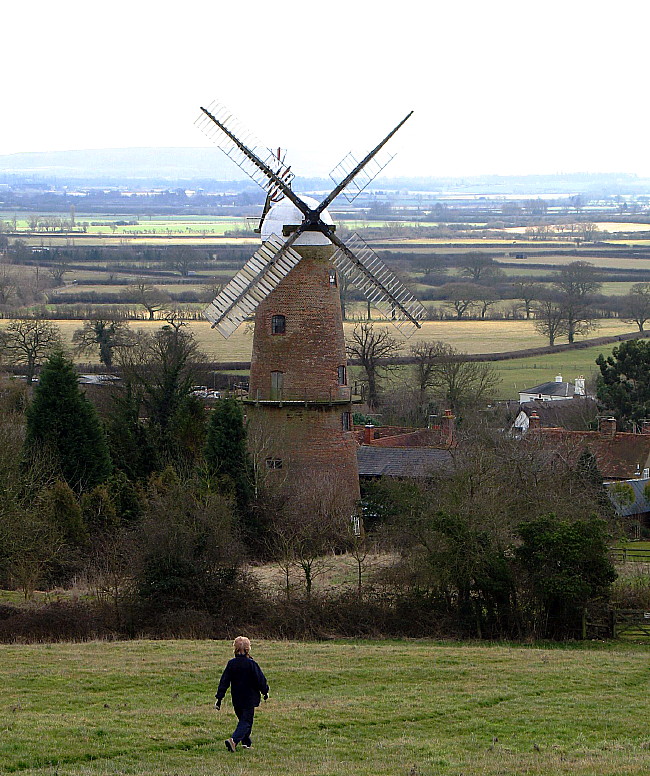|
CHAPTER XI.
QUAINTON TOWER MILL

Fig. 11.1:
Quainton tower mill from Simber Hill.
The great tower mill at Wendover has an air of power and majesty
about it, whereas that at Quainton excels in elegance and good
looks. Its slender, gently tapered body stands over 70 feet
tall, making it, so its keepers claim, the tallest windmill in
Buckinghamshire — however, when compared with the six floors and
massive cap of Wendover Mill,
there can’t be much in it. As a landmark, Quainton Mill stands
proud and prominent and, when driven, it is sheer delight to see its
slowly-revolving sails play flitting change with sun and shade.
But despite its modern construction, as a windmill Quainton was not
a great success commercially due mainly to its poor position some
250 feet beneath the peak of Simber hill, which stands immediately
behind it:
“The one great mistake with Quainton Mill
was to put it at the foot of the hill instead of on top — 350ft
above the Ordnance datum with a 600 ft summit just behind it.
The east winds were cut off by the hill, the north winds by the
trees, whilst the west winds were deflected by the recoil off the
hill and the south winds were broken by the trees and houses; so the
mill — a masterpiece of the millwright’s art — never did much good .
. . .”
Unpublished manuscript
(1939) by Stanley Freece,
Centre
for Buckinghamshire Studies.
Referring to the nearby Curtis’s
Mill, a renovated post mill, Stanley Freece was told that:
“She was a nice little fast-running mill,
she would always go, even when the giant tower mill refused to
start.”
Unpublished manuscript
(1939) by Stanley Freece,
Centre
for Buckinghamshire Studies.
. . . . the giant tower mill being Quainton.

Fig. 11.2:
some of the locally made bricks.
Built by James Anstiss, construction began in 1830, but when the
tower had reached what became the third floor, work ceased and a
temporary thatched roof protected the structure while Anstiss went
to America. On his return, work continued and was completed in
1832. To celebrate the event, James Dubney, one of his
workmen, is said to have climbed the mills highest sail to celebrate
the event by drinking to its success, not realising that the brake
was not on — fortunately for him the sails did not turn.
The mill was built from hand-made bricks, the clay for which was
taken from a nearby pit, moulded, and burnt on site. The tower
was constructed from the inside along the lines of an industrial
chimney of the era, no external scaffolding being necessary.
The tower has six floors plus the cap, its two pairs of under-driven
stones being on the fourth. The machinery, much of which is
iron, was installed by the millwright
William Cooper of Aylesbury,
who shortly after the mill’s
completion was declared bankrupt (and disappeared from the scene).
Thus, in place of the great timber post seen in local post mills and
in the smock mill at Lacey Green, the upright shaft at Quainton is a
slender iron pole, some 8 inches in diameter. The arrangements
for rotating the cap are the same as those at Wendover, the cap
being mounted on iron rollers which run upon an iron curb, forming,
in effect, a roller bearing. |
